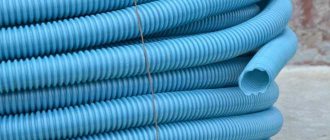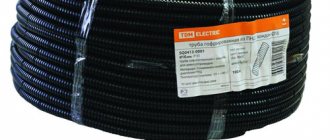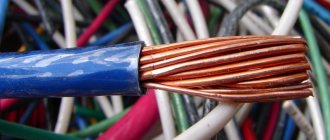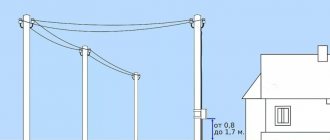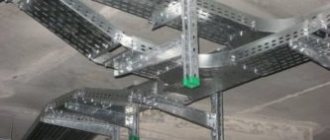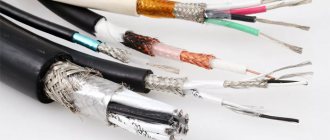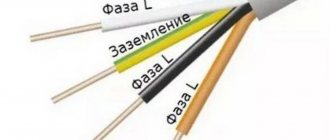When carrying out electrical installation work, cable trays are necessary for laying the main power supply line with a heavy load over long distances.
They protect cables from external damage, preserve the aesthetics of the room, and hide cables that are not suitable for the interior of the room. The design of cable trays is not complicated and is made in the form of a trench made of various materials, with covers and perforations.
The inner surface of the trench is treated to avoid damage to the cable during installation. One or several cables can be laid in such trays.
Reinforced concrete tray - design features and dimensions
Structurally, the reinforced concrete tray is a prefabricated structure of a U-shaped profile, for the manufacture of which the following materials are used:
branded concrete made on the basis of Portland cement marked M400 and higher. Sand purified from impurities, granite screenings and crushed stone are used as filler. If it is necessary to use products in aggressive environments, sulfate-resistant cement is used. High-quality concrete marked B15-B25 contains special additives and modifiers that increase the moisture resistance of the material, strength characteristics and frost resistance;
Trays are made of concrete grade M-200 and higher, strengthening it with steel rods from class A-I, A-II reinforcement or Bp-I wire
high-quality steel reinforcement, the characteristics of which meet the requirements of regulatory documents. A spatial reinforcement frame is made from metal rods of class A1-A3, the configuration of which corresponds to the profile of the cable channel. By strengthening concrete with steel reinforcement, the strength characteristics of a reinforced concrete structure, which can withstand significant loads from the mass of the soil and frost heaving of the soil, are increased.
The design of the product and the composition of concrete allow the product to be used in various climatic regions of the country. Reinforced concrete products have unique characteristics, such as an increased margin of safety, increased moisture resistance, resistance to freezing and correct geometry. The floor slabs supplied with the trays act as covers and are made from the same building materials as the products themselves.
When performing installation operations, products of various sizes are used. Manufacturing companies produce a wide range of additional trays, allowing you to select a product of the required length.
Depending on the design, the overall dimensions and weight of products are standardized and vary within the following limits:
- length is 0.74-3.95 m;
- the width is in the range of 0.28-2.38 m;
- height is 0.28-1.18 m;
- weight varies in the range from 100 to 2700 kg.
Dimensions
Trays are made in rectangular and trapezoidal shapes with a slope of internal walls. Their main dimensions:
- The standard length is 5970 mm; small concrete products of initial numbers have this standard size (at the discretion of the manufacturer, their length can be 2970 mm). Heavier, large-sized products starting with numbers L25 (weight more than 5 tons) are produced in sizes of 2970 mm for ease of transportation and installation;
- for all additional products with index d, the standard length is 720 mm;
- the width of the trays ranges from 420 mm to 4000 mm with the following gradation: 420 mm (L1); 570 mm (L2); 780 mm (L3 - L5); 1160 mm (L6 - L9); 1480 mm (L10 - L13); 1840 mm (L14 - L18); 2160 mm (L19 - L22); 2460 mm (L23 - L26); 2780 (L27 - L30); 3380 (L31 - L34); 4000 (L35 - L38);
- the height of the walls increases with increasing serial number and ranges from 360 mm for L1, L2 to 1700 mm for L38.
- wall thickness from 40 mm (L1) to 100 mm (L38);
- internal channel width - from 300 mm to 3600 mm;
- height of the tray from the inside from 300 mm to 1500 mm;
- bottom thickness - from 60 mm to 200 mm.
- the mass of the trays varies from 0.9 t for L1 with a concrete volume of 0.34 m3 to 9.38 t with a material volume of 3.75 m3 for L38.
- slabs of type KL and KLp are produced with a length of 2990 mm; for reinforced concrete products with an internal width of 300 and 450 mm, the length of the slabs is 740 mm.
- for additional prefabricated concrete products of 720 mm, the length of the overlapping slabs is 740 mm.
Installation diagram of reinforced concrete channels
Mounting methods
In the case of reinforced concrete cable trays, everything is clear: they are simply laid in pre-dug trenches, then hidden under a layer of earth. Metal and plastic profiles can be attached to the wall in four main ways. It all depends on the specific fasteners:
- self-tapping screws;
- liquid Nails;
- "bugs";
- dowel-nails.
Self-tapping screws are usually used in the process of attaching trays to wooden products, while dowel-nails are suitable for fixing to concrete walls. “Bedbugs” are metal screws. They can be used when there is a need to install a profile on metal walls up to 2 mm thick.
Often, none of the three methods listed above is suitable. For example, you cannot use dowels or any screws to install trays on tiled walls. In this case, liquid nails come to the rescue.
Concrete tray - the main types of tray products
Various types of trays are used in the construction and industrial sectors:
- U-shaped and rectangular profile products for the construction of prefabricated channels. Reinforced concrete cable trays are characterized by increased overall dimensions, allowing free placement of electrical communications for various purposes. The amount of free space inside the trays also allows them to be used to drain significant volumes of storm water. Prefabricated products have an increased margin of safety, as well as increased resistance to corrosion processes. This allows them to be used in soils with high humidity, as well as in the zone of soil freezing;
- trapezoidal telescopic trays of U-shaped configuration. Produced under production conditions, the products have precise overall dimensions. This greatly facilitates the pairing of trays during installation. Installation of telescopic trapezoidal trays is carried out in groups to ensure the required length of the line. The product is intended for installation along roadsides for accelerated drainage of precipitation. A distinctive feature of telescopic trays is their reduced water absorption, which significantly increases the duration of use of products of this type.
According to their functional purpose, design features and installation specifics, trays are divided into the following types:
- products for energy purposes, marked with the designation UBC or UBS;
- drainage and water disposal products marked MZhBL;
- tray channels for thermal routes and highways of type L;
- products for railway communications of the MPL or MSHL brand.
Reinforced concrete cable trays are used for laying electrical cables
Installation
Installation of trays consists of the following steps:
- Marking the working surface according to the design documentation, as a result of which a center line is drawn on the wall or ceiling;
- Drilling holes for fasteners for supporting elements;
- Fastening of supporting elements: brackets, shelves, suspensions, consoles;
- Fastening to the supporting elements of trays and shelves (for mounting trays on the wall);
- Connecting sections located at an angle relative to each other using turns, tees, and crosses.
The difference in installing trays on the wall and ceiling lies in the type of support elements used. When installing a tray horizontally, cable shelves with long racks are used, while when installing boxes near the ceiling, their analogues with shorter racks are used, which have a platform at the base with two holes for attaching fittings to the studs screwed into the ceiling. Also, to attach mesh trays to the ceiling, special hangers are used, consisting of a long pin, two square clamping pads, and two nuts.
At the final stage of installation, communications are placed in cable trays and a full list of work is carried out to connect and check them, in accordance with the current operating rules for electrical installations. Laying live communications is prohibited.
Cross-country ability calculation
Typically, the calculation is carried out by designers, and this document is part of the overall design of the surface drainage system. The calculation is complex; it requires selecting special values of certain coefficients from tables.
But there is a so-called simplified calculation, consisting of one formula. It uses three indicators that are multiplied among themselves:
- F is the area of the territory from which rain and melt water will be collected into the drainage system. It is measured in hectares (Ha).
- q20 – precipitation intensity coefficient. Rain is usually taken into account. The value of this indicator differs by region. For example, in Moscow – 80, in St. Petersburg – 60. The value is in a table.
- φ – absorption coefficient. This refers to absorption by the material from the surface of which water is drained into the trays. For example, from asphalt paths or platforms the coefficient is 0.95. From the ground – 0.4. The denser the material, the higher the coefficient and the lower the water absorption. From them, more water will flow into the gutters, which means their cross-section should also be larger.
After multiplying the data, the value of the volume of water that the surface drainage trays can contain and be moved by gravity to its destination is obtained. Next, in a special table, find the brands of gutters that correspond to the result obtained.
Types of cable trays
The trays in which the cable is laid differ in design, as well as in the materials from which they are made. There are also differences in application features. The structure can be made of the following materials:
- metal;
- plastic;
- concrete (reinforced concrete).
Metal cable tray is usually made by stamping from thin sheet mild steel. Depending on the operating conditions, the following types of anti-corrosion treatment can be used:
- Cold galvanizing (using the Sendzimir method). With this method, coiled steel is rolled continuously through a zinc bath. After this, the cable tray is molded from galvanized sheet. The advantage of the method is speed. The disadvantage is the thin protective layer of zinc. Typically, boxes intended for indoor installation are made this way.
- Hot galvanizing involves dipping a finished product into molten zinc. In this case, corrosion protection is more reliable. Such trays can be used for outdoor installation.
- Painting with special enamels containing anti-corrosion additives. Can be used as an additional measure of protection for already galvanized products.
For operation in particularly harsh conditions, the cable tray is made of stainless steel sheet. Cables are laid in trays made of this material, which has high hygienic qualities, at food industry enterprises. The use of wire trays, one of which is shown in the photo below, can significantly lighten the design of the cable system while maintaining sufficient mechanical strength:
Plastic cable tray. The low strength characteristics of this material limit their use. These types of trays are used when it is necessary to lay power or telecommunication wires or cables of a relatively small cross-section inside residential and industrial buildings. Trays of this type are relatively small in size.
The use of plastic boxes and channels is due to a number of advantages:
- PVC cable tray is relatively inexpensive;
- structures made from this material are lightweight;
- the PVC cable duct is easily deformed, so the wiring route can be easily adjusted during the installation process;
- PVC products fit well into the interior of residential and industrial premises.
Plastic cable channels also have disadvantages:
- rapid wear during operation, fragility of structures, which affects the need to replace or repair the cable;
- tendency to deform when cables are heated;
- are used to mount the cable indoors; they are not used for outdoor installation.
It should also be noted that a cable tray made of metal or plastic can have different designs and sizes. The list below shows what types of product designs there are:
- open tray;
- closed type, equipped with a lid;
- perforated;
- non-perforated.
Open and perforated models are good because they create favorable conditions for cooling the current-carrying conductors that are laid in them. Non-perforated trays with a hermetically sealed lid are used in cases where the cable needs to be protected from exposure to aggressive atmospheric components or moisture. The lids of such products have a special locking device that ensures the tightness of the structure.
Well, the last option that I would like to talk about is a concrete cable tray. The main area of application of reinforced concrete trays is laying cable routes underground or on the ground surface. This is due to the high strength that these types of products possess and their ability to withstand the harmful effects of ground moisture for a long time, protecting the cable. Concrete trays usually have larger dimensions than products made from other materials. When designing open switchgear substations, a concrete cable tray has practically no alternative at present. All cabling in such electrical installations is laid in concrete boxes and covered with covers made of concrete, steel or asbestos-cement slabs.
What are the types of cable channels for electrical wiring: what is it?
A cable duct is a metal or plastic box for electrical wiring that can be used indoors and outdoors. The design consists of a body and a cover. Most often they have a square or rectangular cross-section. The body can be perforated or solid. The body part and the cover are connected using a special lock.
Plastic structures that can look like skirting boards are popular
Cable boxes are mounted in different systems. They come in a variety of colors and are highly aesthetic. The internal space can be divided by partitions. This allows you to separate low-current and power cables, which are laid separately
When choosing plastic products, you should pay attention to the non-flammability of the material.
Using a wood channel instead of a plinth
There are different types of cable channels:
Mini. The channels have a small diameter and are used for laying Internet, television or telephone lines. 1-2 wires of medium thickness are placed in such a channel. They are made of plastic and attached to the walls using screws and glue. The channel cross-section varies between 10×10 and up to 60×80 mm;
Miniature channels can be made of metal or plastic
Parapet guides. They are made of plastic, but are larger in size. Such structures are installed in apartments and offices. You can adjust the rotation angle from 7 to 45 degrees. It is convenient to connect sockets and switches to such guides. The cross-section of structures varies from 10×20 mm to 100×60 mm. In this case, the profile type can be W-shaped, L-shaped or T-shaped. Also, profiles can be universal or curly;
Parapet products are perfectly fixed to the wall
Skirting. These channels are installed at the junctions of walls and floors. Inside these skirting boards there are cavities for laying wires. The dimensions depend on the width of the diagonal wall, which can be 50 or 70 mm. Such channels are used for any premises and are resistant to temperature changes. Such channels are fastened using self-tapping screws. The joints are covered with corners and plugs;
Option for plinth with installation of wires
Flexible channels. The structures are corrugated and chain. The latter protect the wires from vibrations, mechanical damage and chemical exposure. They are corrosion resistant, flexible and open access. Corrugated structures are made of non-flammable plastics;
Flexible products are often used in office premises for cable routing in difficult areas
Corner ceiling channels. They are plastic parts in the shape of a triangle. The joints are cut at an angle of 45 degrees and closed with plugs. The box has a beautiful appearance and color palette. The size of the internal part can be 40×40 mm;
There may be several partitions inside the corner housing
Floor-standing. Cable trays are required when you need to run wiring to lighting fixtures or to a table. At the same time, the color scheme is not very diverse. The most commonly used palette is white, black or gray;
Floor channels are complemented by inserts for switches
Transparent channels for LED strips. Inside the box there is a partition to which the LED is fixed. The width of the tape can be 5-20 mm.
Channels with LEDs can be located in baseboards
How to choose the right cable channel can be seen in the video:
When choosing products, you need to pay attention to GOST standards for cable channels. The possibility of installation depends on the degree of flexibility and rigidity
Rigid structures can be in the form of boxes with holes or blind boxes. Flexible cable channels are represented by corrugated pipes, tracks and chains.
Corrugated lines make it easier to install wiring in hard-to-reach places
Characteristics
What technical characteristics influence the choice of tray?
- The length of an individual structural element. Usually it is 3 meters: with a longer length, both installation and transportation of the tray indoors are difficult.
- Width, height of the guide profile and thickness of its metal. These parameters are interrelated: the wider the tray, the more space there is for the cable, which means the greater the load on it. Consequently, the requirements for strength also increase. As an example of the model range, let's look at the products of the Italian brand DKC. The buyer is offered products with a width of 200 to 600 millimeters with a guide profile height of 50, 80 and 100 mm. The thickness of the guide (spar) is 1.2 millimeters for younger models and 1.5 for older ones. The price of products is proportional to the consumption of materials for their production - approximately from 500 to 1000 rubles.
DKS tray 200x50 millimeters.
- The load on the tray evenly distributed over the area can reach 300 kilograms per linear meter. If the product is sufficiently strong, it is worth remembering an additional limiting factor - the load-bearing capacity of the structure on which the tray is attached.
- All ladders are by definition IP 00 - simply because they are open structures.
- The operating temperature range for all metal staircase channels is from -60 to +90 degrees. The lower limit is due to the brittleness of the metal at extremely low temperatures (primarily in relation to impact load). The upper one – the capabilities of the plastic clamps used to secure the cable and the insulation itself.
Types of cable trays
The trays in which the cable is laid differ in design, as well as in the materials from which they are made. There are also differences in application features. The structure can be made of the following materials:
- metal;
- plastic;
- concrete (reinforced concrete).
Metal cable tray is usually made by stamping from thin sheet mild steel. Depending on the operating conditions, the following types of anti-corrosion treatment can be used:
- Cold galvanizing (using the Sendzimir method). With this method, coiled steel is rolled continuously through a zinc bath. After this, the cable tray is molded from galvanized sheet. The advantage of the method is speed. The disadvantage is the thin protective layer of zinc. Typically, boxes intended for indoor installation are made this way.
- Hot galvanizing involves dipping a finished product into molten zinc. In this case, corrosion protection is more reliable. Such trays can be used for outdoor installation.
- Painting with special enamels containing anti-corrosion additives. Can be used as an additional measure of protection for already galvanized products.
For operation in particularly harsh conditions, the cable tray is made of stainless steel sheet. Cables are laid in trays made of this material, which has high hygienic qualities, at food industry enterprises. The use of wire trays, one of which is shown in the photo below, can significantly lighten the design of the cable system while maintaining sufficient mechanical strength:
Plastic cable tray. The low strength characteristics of this material limit their use. These types of trays are used when it is necessary to lay power or telecommunication wires or cables of a relatively small cross-section inside residential and industrial buildings. Trays of this type are relatively small in size.
The use of plastic boxes and channels is due to a number of advantages:
- PVC cable tray is relatively inexpensive;
- structures made from this material are lightweight;
- the PVC cable duct is easily deformed, so the wiring route can be easily adjusted during the installation process;
- PVC products fit well into the interior of residential and industrial premises.
Plastic cable channels also have disadvantages:
- rapid wear during operation, fragility of structures, which affects the need to replace or repair the cable;
- tendency to deform when cables are heated;
- are used to mount the cable indoors; they are not used for outdoor installation.
It should also be noted that a cable tray made of metal or plastic can have different designs and sizes. The list below shows what types of product designs there are:
- open tray;
- closed type, equipped with a lid;
- perforated;
- non-perforated.
Open and perforated models are good because they create favorable conditions for cooling the current-carrying conductors that are laid in them. Non-perforated trays with a hermetically sealed lid are used in cases where the cable needs to be protected from exposure to aggressive atmospheric components or moisture. The lids of such products have a special locking device that ensures the tightness of the structure.
Well, the last option that I would like to talk about is a concrete cable tray. The main area of application of reinforced concrete trays is laying cable routes underground or on the ground surface. This is due to the high strength that these types of products possess and their ability to withstand the harmful effects of ground moisture for a long time, protecting the cable. Concrete trays usually have larger dimensions than products made from other materials. When designing open switchgear substations, a concrete cable tray has practically no alternative at present. All cabling in such electrical installations is laid in concrete boxes and covered with covers made of concrete, steel or asbestos-cement slabs.
Drainage sluices
They are used when laying sewers, drainage, collector lines, and for installing various segments of hydraulic structures. Reinforced concrete trays free roads from water during rainy weather.
Return to ContentsReturn to ContentsReturn to Contents
Varieties
This kind of reinforced concrete structure can come in different shapes and sizes. The following types of reinforced concrete trays are found:
- U-shaped;
- trapezoidal;
- parabolic.
Product sizes depend on the manufacturer's brand. For example, the ERBA company produces products in the following sizes: 0.72–6/0.4–1.84/0.38–1.32 – length/width/height, measured in meters. In addition, the drainage tray can be monolithic or prefabricated. According to their purpose, reinforced concrete gateways are divided into:
- Edge. Protect roads from being washed away by runoff water. Mounted on the border of the road and sidewalk.
- Telescopic. Often used in mountainous areas. The shape resembles a truncated cone, making the assembly process of the product easy.
- Linear. They have a wide variety of assortments and are often produced in a U-shaped form.
Trapezoidal drainage sluices.
According to production technology, reinforced concrete gutters are found:
- Manufactured by vibratory casting - implies “shaking” the solution poured into the mold on a vibrating table. In this case, the mixture lies unevenly - more on the outer edge. The cost of such trays is small, but the quality is rather questionable. This method is considered very old and impractical.
- Vibro-pressed. This method is more modern and reliable. It uses a high-quality solution, which, in addition to vibration, is pressed under high pressure. The quality in these trays is impeccable.
Return to contents
Advantageous qualities and characteristics
- No material of similar purpose can compete with reinforced concrete trays in terms of strength and durability.
- Practice shows that reinforced concrete gutter can serve properly for 70 years, due to which this material is considered quite economical.
- The strength of a reinforced concrete tray deserves all praise, because it can withstand colossal loads. Therefore, for laying various communication systems in the area of road sections where there is constant traffic flow, reinforced concrete gutters should be used.
- These structures can withstand significant temperature changes. The maximum thermometer readings for gutters are 350 degrees, the minimum is -40.
- Due to their massiveness and heaviness, the trays are difficult to move after installation. Therefore, they are not afraid of floods, heavy rains, or the release of groundwater.
- The reinforced concrete mixture is resistant to corrosion, which is of great importance for drainage gutters.
- This material is environmentally friendly and safe.
Reinforced concrete trays have some disadvantages:
- Such structures weigh a lot, which makes their delivery to their destination more complicated and requires some expense.
- To install a reinforced concrete drainage line, you will need the help of professionals. An ordinary person without experience will not be able to achieve this alone.
- The heavy weight of reinforced concrete gutters requires thorough fastening. Therefore, foundations are built for such structures.
- Aesthetically, gateways made of reinforced concrete mixture are not particularly attractive. This drawback can be eliminated using decorative lattice covers.
Return to contents
What is important to know
The main element of the electrical box design is a U-shaped profile, the length of which is 2 meters. The product kit includes a lid to close the internal cavity of the product. The profile is attached to the wall or ceiling, power cables or control wires are laid in it, after which the wiring is closed with a quick-release cover. The material from which the boxes can be made is galvanized steel, aluminum or durable plastic that does not support combustion. You can learn more about what types of cable channels there are in our separate article.
The range of products that perform cable channel functions is very diverse, as can be seen in the photo above. These can be wall boxes and floor skirting boards, as well as corrugated pipes and trays. As a rule, skirting boards are designed to accommodate low-current cables and wires; corrugated pipes and trays are used for installation in utility rooms and on the surface of external walls. For arranging the energy supply of premises, the most popular are wall-mounted electrical boxes made of plastic with a double-sided lock. In addition to the most common white cable channels, the industry has launched the production of products in a wide variety of colors that can complement the interior of any room.
Tags: sconce, view, harm, choice, house, , clamp, protective, cable, cable, how, design, crown, , tray, installation, voltage, rule, wire, project, laying, cable laying, start, , size, repair, row, garden, light, LED, ten, type, current, triangle, , installation, photo, shield
Main Dimensions
The standard sizes of trays are usually determined by two numbers indicating the width and height of the product in millimeters. For example, the designation 50x50 refers to a tray whose width and height are 50 millimeters. These sizes are basic. In addition to them, the length of the tray section and the wall thickness are indicated. We have provided some sizes of cable trays in tables for your reference.
Reinforced concrete structures:
Plastic:
Metal:
So we looked at the main sizes and types of cable trays. As you can see, there are a large number of design options and standard sizes of products, so you can choose the best option for your own application conditions!
It will be useful to read:
- Types and sizes of metal hoses for electrical wiring
- Rules for laying cables in trays
- Methods for attaching a cable channel to a wall
Published: 07/03/2017 Updated: 05/02/2019

